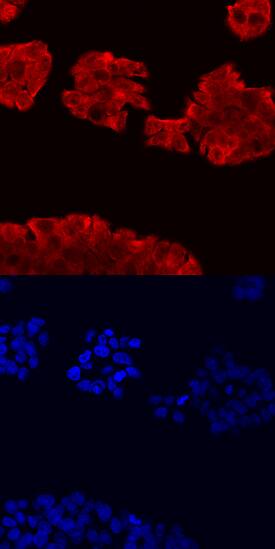Human PAR1 Antibody
R&D Systems, part of Bio-Techne | Catalog # AF3855

Key Product Details
Species Reactivity
Validated:
Cited:
Applications
Validated:
Cited:
Label
Antibody Source
Product Specifications
Immunogen
Arg27-Thr102, Ser375-Thr425
Accession # P25116
Specificity
Clonality
Host
Isotype
Scientific Data Images for Human PAR1 Antibody
Detection of PAR1 in HT‑29 Human Cell Line by Flow Cytometry.
HT-29 human colon adenocarcinoma cell line was stained with Human PAR1 Antigen Affinity-purified Polyclonal Antibody (Catalog # AF3855, filled histogram) or isotype control antibody (Catalog # AB-108-C, open histogram), followed by Phycoerythrin-conjugated Anti-Goat IgG Secondary Antibody (Catalog # F0108).PAR1 in HT‑29 Human Cell Line.
PAR1 was detected in immersion fixed HT-29 human colon adenocarcinoma cell line using Goat Anti-Human PAR1 Antigen Affinity-purified Polyclonal Antibody (Catalog # AF3855) at 10 µg/mL for 3 hours at room temperature. Cells were stained using the NorthernLights™ 557-conjugated Anti-Goat IgG Secondary Antibody (red, upper panel; Catalog # NL001) and counterstained with DAPI (blue, lower panel). Specific staining was localized to cytoplasm. View our protocol for Fluorescent ICC Staining of Cells on Coverslips.Applications for Human PAR1 Antibody
CyTOF-ready
Flow Cytometry
Sample: HT-29 human colon adenocarcinoma cell line
Immunocytochemistry
Sample: Immersion fixed HT-29 human colon adenocarcinoma cell line
Western Blot
Sample: Recombinant Human PAR1
Formulation, Preparation, and Storage
Purification
Reconstitution
Formulation
Shipping
Stability & Storage
- 12 months from date of receipt, -20 to -70 °C as supplied.
- 1 month, 2 to 8 °C under sterile conditions after reconstitution.
- 6 months, -20 to -70 °C under sterile conditions after reconstitution.
Background: PAR1
Human Proteinase-Activated Receptor 1 (hPAR1), also known as thrombin receptor, is a 65-70 kDa, 399 amino acid long member of the seven-transmembrane superfamily of cell-surface G protein-coupled receptors. PAR1 is activated by thrombin cleavage of its N-terminal propeptide in the extracellular domain. Human PAR1 is widely expressed in many cell types including endothelial cells, and it has been implicated in a variety of inflammatory responses. Over the regions used as immunogen, human and mouse PAR1 proteins are 58% identical in the region spanning the propeptide and extracellular domains, and 84% identical in the cytoplasmic tail.
Long Name
Alternate Names
Gene Symbol
UniProt
Additional PAR1 Products
Product Documents for Human PAR1 Antibody
Product Specific Notices for Human PAR1 Antibody
For research use only

